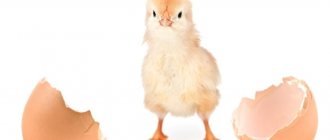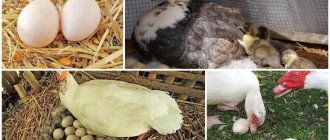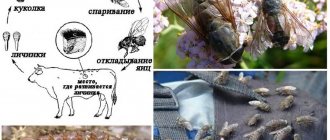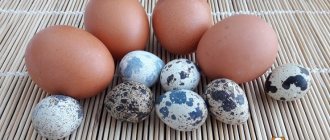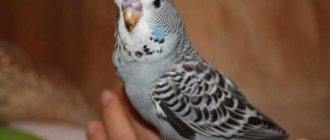Features of the chicken body
Nature has endowed chickens with the ability to regularly reproduce eggs. Depending on the variety, females begin laying eggs at 4-8 months. At this age, laying hens reach sexual maturity.
Find out in more detail when the first egg laying begins in chickens of different species and productive orientation, in the article “At what age do chickens begin to lay eggs.”
The reproductive system of the chicken body is similar to that of the female. Bird eggs are also regularly produced one after another. The difference is that in a chicken, the unfertilized egg is released.
But before that, it goes through several stages, gradually forming into an egg. This happens in the special genital canals of the chicken.
How do chickens reproduce? Is a rooster required or do they lay eggs without one?
The process itself does not look erotic. The hen runs away with a wild cry, the rooster catches up and, rather painfully, I think, dances on her back. There can be no penetration; this very liquid simply pours out. Due to the vigor of roosters, the ratio should be somewhere around 1:10, for 1 rooster 10 hens. My parents somehow reduced it to 1:4, the chickens were painful to look at, their backs were covered in bloody calluses. “
“It is known that the vast majority of bird species (97%) do not have a penis. Fertilization in them occurs through the so-called “cloacal kiss,” a short-term contact of the cloacae - openings that birds also use to excrete waste products. . The exception is ducks, especially wild ones. . The male penis also has a corkscrew shape, but it is twisted in the opposite direction (counterclockwise). Thus, it turns out that in the process of evolution, duck oviducts have acquired a shape that prevents penetration of the penis, and in order for sperm to approach unfertilized eggs, the female must be relaxed and friendly. “
Transformation into an egg
An egg forms in the left ovary of the hen, which forms and grows into a yolk.
Having reached a size of 4 centimeters, the yolk moves into the oviduct. A protein shell is created. After 3 hours, the protein is completely formed. The egg then moves along the isthmus of the oviduct.
The last stage is the formation of the shell. This lengthy process lasts 17-19 hours. Afterwards, the finished egg is born.
It takes a chicken one day to lay an egg. The process and its features are described in full in the article “How chickens lay eggs.”
According to the above, we can conclude that the rooster does not affect egg laying and the appearance of testicles outward. But this does not mean that it is not needed at all.
Let's look at the advantages and disadvantages of keeping a rooster.
Chickens' love ritual
Since chickens live in a community, there must certainly be a strict structure in it, at the top of which the most authoritative rooster dominates. But it happens that even the strongest and strongest rooster cannot fight back the smaller one - then leadership is transferred to the latter.
In a chicken family, the most authoritative rooster dominates.
The leader of the community is endowed with significant advantages over other gentlemen. He has the right to mate with any hen and conduct a love ritual at any time convenient for him. The hen does not enjoy the mating process, since the male sits on her back and grabs the back of her head with his beak. You can often observe how the female tries to escape from the excited male, and sometimes she succeeds.
Showing his dominance, the leader constantly looks after the chickens and behaves like a true gentleman. Flirting, he walks around the chicken and scratches the drooping wing with his foot. And having acquired a tasty morsel, without hesitation, share your prey with the female you like. It seems that his tenderness and attention have no boundaries.
The leader watches the chickens and looks after them.
However, with the onset of molting, the situation changes dramatically. The rooster stops showing concern, begins to trample the hens and aggressively drives them away from the feeders and drinkers. With the end of the molting period, peace and idyll return to the chicken family.
Does the male influence the quality of the clutch?
There is an opinion that eggs laid by a cockerel are healthier than unfertilized ones. However, there are other factors that influence the quality of masonry.
To improve egg production, the following indicators must be taken into account:
- conditions of detention and nutrition;
- breed of chickens;
- internal climate in the chicken coop.
The average chicken lays eggs once every two days. A balanced diet rich in vitamins and minerals promotes the laying of eggs every day. A laying hen weighing 1-2 kilograms can lay eggs every day.
Healthy food and constant walks in the fresh air increase egg production and productivity. In order for a chicken to lay eggs more often, you need to take care of proper care and maintenance.
For more information about the factors influencing the productivity of laying hens, read the article “What determines egg production in chickens and how to increase it at home.”
Now let's talk about the positive and negative aspects of fertilized eggs.
Increasing egg production
If a farmer is faced with the problem of poor quality chicken products, then it is not necessary to get a rooster on the same day. First, it’s worth reviewing the hens’ diet: their traditional menu may lack vitamins or minerals. There is no need to buy expensive food: we are talking about fresh and boiled vegetables, lime, and natural grain. Let us remember the basic rule of Soviet poultry farming: in order for the yolk to have a rich color, it is worth including nothing more than corn in the chicken diet.
Do not forget that the products must be clean, high quality and fresh.
On the shelves of most pet stores you can find nutritious feed both to maintain the general condition of chickens and to increase egg production.
As a conclusion, we can say that the chicken actually lays eggs without the help of a rooster. The presence of the latter in the chicken coop cannot be called a whim, since without its participation fertilization is impossible, as well as the safe functioning of laying hens.
Features of fertilized testicles
Main
There is no obvious difference between fertilized and unfertilized eggs. The only difference is the ability to hatch a chicken from the first copies.
The seminal fluid of the rooster remains in the body of the hen for a month. All this time, the chicken lays fertilized eggs. Their number can reach several dozen from one individual.
Myths and reality
Many argue that fertilized eggs are many times tastier and healthier than regular eggs. Supposedly they have a brighter yolk. There is even a legend that they help cure severe cancer. And millions of people believe in such myths.
But experts and professionals say that the problem is not the male, but the proper diet, walking and keeping of the hens. And the color of the yolk is influenced by the foods that the chicken often eats. The composition of the testicles does not change due to the participation of the rooster in their creation.
It is believed that eggs obtained with the participation of a male are dietary for 5 days, and ordinary eggs for a week. However, both types remain equally fresh. And tableware too: from 26 to 30 days, subject to proper storage.
Continuing the topic, we recommend that you read the article “Storing chicken eggs and their shelf life.”
Calculating “live”
It is almost impossible to determine “by eye” whether an egg is fertilized or not. Therefore, a lamp or an ovoscope is used for this purpose.
When translucent, a blood clot is sometimes observed in the yolk. This means that the egg was born with the participation of a rooster. This means it is fertilized. Such eggs are found when purchasing products from private farmers.
Factory eggs are unfertilized. And the likelihood of finding a chicken embryo in them is minimal. Employees carefully inspect them and reject them.
The main functions of a chicken coop owner
In many villages there is a belief that if there is no rooster with the hens, productivity will be lower. This is another misconception; chickens will lay the same number of eggs, but not fertilized ones.
Having a rooster in the flock is useful:
- To raise your own chickens.
- To stimulate walking chickens.
- To increase egg production (without a rooster, this property fades faster).
- If you want to have a singing rooster.
- As a chicken guard (but roosters are not always brave).
- Allows chickens to live 35 years longer.
- For a decorative role.
- Have delicious Sunday broth.
To ensure that the egg production of chickens without the participation of a rooster does not decrease, the diet of laying hens must contain proteins (cake, cottage cheese, mixed feed, etc.). It is necessary and possible to give minerals, the strength of the shell depends on them (crushed shells, chalk, lime, chicken shells). In the summer, give them greens and fresh vegetables, special feed containing carbohydrates.
What is a rooster for?
Role of the manufacturer
In the chicken coop, the rooster plays the role of the male sire. Chicks are born only from fertilized eggs.
The factor is important for breeders: it makes no sense to buy incubators. Eggs produced without the participation of a male will never produce offspring. "Empties" are only suitable for human consumption.
We can conclude that the breeder decides whether to have a rooster for hens or not based on his goals. Accordingly, the presence of a male is necessary to hatch chicks. The bulk of the flock consists of laying hens. They provide the farmer with eggs, meat, and feathers.
Other roles
Above, we found out whether chickens lay eggs without a rooster. Now let’s figure out why the presence of a male is necessary for the herd.
Roosters in the chicken coop play the role of leader of the flock. Chickens need a “head of the family.” They obey him, they obey him. The male maintains discipline in the pack. Looks after each chicken, takes care.
It is the leader who ensures that the hens take their place at the feeder and nest. In addition, chickens need a rooster for safety and protection. Its presence in the chicken coop guarantees the safety of the flock. Males will defend against an enemy of any size. Sharp spurs, beak and claws will repel predators.
You need to start a manufacturer because of the aesthetic aspect. Bright plumage, long tail and five-fingered crest decorate any yard.
In addition to beauty, a rooster in a chicken coop has food benefits. Males quickly gain weight. It is advisable to use its carcass for meat. The weight of an adult rooster reaches 3-5 kilograms.
However, roosters also cause harm to laying hens.
Arranging a nest for incubating chickens
If you want to hatch chickens, you need to know how many days the hen hatches the chicks. First, they take care of equipping the nest in a secluded place. In the poultry house, together with other chickens, the hen feels anxious, so it is better to separate her into a secluded room or place the nest in a fence.
Incubation nest
Breeding offspring according to plan:
- For the nest, choose any basket or box, lay dry grass on the bottom, and straw on top. The material is placed evenly throughout the nest so that the eggs do not roll down in the center or roll to the sides. A hen that is prone to incubation makes bubbling sounds, sits in the nest for a long time, and stops laying eggs. She loses her appetite, eats and drinks less, and does not let the male near her.
- The hen begins to tear fluff from the abdomen, lining the selected nest. She is provoked to incubate in the nest with a lining egg. As soon as the bird gets used to the nest, it is covered with a box with a mesh bottom for the day.
- After several days, the behavior of the selected chicken is monitored. If she stays too long in the nest and has to be driven to the feeder by force, then you can start laying a batch of eggs.
- Only fresh eggs are laid from under several chickens. Those that are dirty, deformed or damaged are discarded; old eggs produce weak and sickly chicks.
- At twilight, the bedding is removed from under the bird, replacing it with fertilized eggs. The hen should rise slightly, helping with her beak to roll the entire batch under her belly.
- The number of eggs depends on the size of the chicken. The optimal option is considered to be from 10 to 15 pieces. The egg-meat breeds are considered the most caring; they can hatch up to 21 eggs.
- The hen rolls the eggs several times a day for uniform heating; if she does not touch one of them, this indicates that the embryo is freezing.
- On the 19th day of incubation, biting begins. At the blunt end of the egg, the chick breaks the shell with its beak.
- The hatching of chicks begins on the 20-21st day.
- The chicks are kept under the hen until they dry out, then they are moved to a warm, heated basket.
Disadvantages of keeping a male
Aggressiveness
Despite the advantages of having a male in the herd, some farmers have a negative attitude towards this possibility. Why do you need a rooster if it is more trouble than it is worth?
Often the male, protecting the chicken family, attacks the owner. In such a situation, an aggressive pet can seriously injure a person.
Lovingness
Overly loving males during “trampling” are capable of injuring laying hens with sharp claws and spurs. In addition to the plucked feathers, the skin suffers.
Scratches may appear on the body of chickens. Infection gets into the wounds, which leads to infection and disease in the birds.
Decreased performance
Poultry farmers note that when chickens have a rooster, their egg production rate decreases. A serious disadvantage of decreased productivity is the “awakened” maternal instinct in laying hens. The fact is that the chicken tends to “sit” on fertilized eggs.
Of course, the desire to hatch chicks is a positive quality of chickens. However, the downside is that the chicken, while hatching the egg, occupies the nest. Such actions make it impossible for other females to lay eggs. Therefore, it is generally accepted that chickens lay eggs better without a rooster.
Some information about poultry farming
The ease of keeping chickens and the ability to feed them cheaply even with leftover food from your table has made them the most popular option for breeding.
It is for this reason that these winged birds can be seen in almost every rural yard. But, if the benefits of them are obvious (fresh and nutritious eggs), then why is there one rooster or more in the chicken coop? Its function is to fertilize the egg, which is nothing more than an egg? But most owners prefer to buy older chickens rather than bother with small chicks. A reasonable question arises: why a rooster and how many males are needed? A six-month-old hen is already capable of laying eggs; her cloaca is greatly stretched. Their number depends on the breed and care, but on average it is about 1 per day. In order to perform this function, she does not need a male. But nature also provides something else - the need for procreation, and here it should not be possible to do without a rooster. It is he who fertilizes the product. Oddly enough, there is an opinion that such eggs are healthier, but this is empty and baseless talk. In terms of composition, taste and properties, they do not differ from unfertilized ones. The only difference is that one of them can hatch into a chicken, while the other cannot.
Selection rules
Age
A male should be selected at the age of 5-6 months. It is not recommended to purchase roosters older than 3 years. By the age of five, their sexual function decreases, and a drop in egg fertilization is noticed.
The age of a bird should be determined by the condition of its spurs. Young males have no appendages on their limbs. There are only formations in the form of tubercles. Full-sized spurs are observed in roosters older than one year.
It should be remembered that in some breeds such processes may be completely absent.
Temperament and appearance
When choosing, pay attention to the character of the future leader. Watch the young cockerels. They must be endowed with a lively, active and cocky disposition. However, the bird should not be overly aggressive towards people and birds. It is better not to acquire an evil individual.
When choosing a rooster, pay attention to its exterior: the color of the feathers, the shape of the body, the condition of the beak, comb, and spurs. If a male is rejected based on at least one characteristic, then it is better not to buy it.
Read more about the qualities of a male in the article “What a rooster should look like: description of a bird.”
Insemination process
So, we already know how birds copulate. How does fertilization of a chicken egg occur? Or rather, eggs. After all, the egg is formed after fertilization of the egg deposits. Although the chronology of the processes is exactly this: fertilization of an egg - the formation of an egg, the latter will be formed without fertilization.
At first, the egg exists as an oocyte - it is also the future yolk, it is also the rudiment of the egg. Oocytes in the ovary look like a bunch of grapes of different sizes. This picture is due to the fact that the eggs that make up the so-called bunch are at different stages of development.
Typically, one oocyte matures per day in laying hens. Rare cases of simultaneous maturation of two eggs produce an egg with two yolks. When the oocyte matures and becomes ready for fertilization, it is released from the membrane, detached from the cluster and moves into the oviduct. When a rooster's cloaca and a chicken's cloaca touch, sperm enter the female's cloaca.
Moving upward, the most lively “tail” finds the egg and penetrates it. This is how fertilization of the egg occurs.
Rooster sperm live in the body of chickens for up to three weeks. The eggs laid by chickens at this time must be “live”. How to determine whether new life has arisen in an egg or not? An ovoscope will help you find out.
If you can’t buy such a device, you can make it yourself. In fact, the simplest ovoscope is just a tube with a diameter of 3 cm and a light source. To determine whether an egg is alive or not, you need to bring it to the source and take a good look through the “device” from the unlit side.
| Age of the embryo | What does the ovoscope show? |
| 5 days | In both living and unfertilized eggs at this stage, a tiny oval is visible on the ovoscope. If the oval is colored less intensely inside than along the contour, the egg is alive, but if the spot is painted evenly, it is not. |
| 6–7 days | This is the period when it is already possible to accurately identify unfertilized eggs: they do not contain a red vascular network. In a living egg, the embryonic spot grows to 5–8 mm. Random red spots appear when the embryo dies. |
| 7–10 days | At this time, it is determined whether the chicken has survived. A pale yolk and a halo around the embryo indicate normal formation of the chick. |
Experts recommend having 1 rooster for every 9-12 females to avoid high competition with frequent fights. Excessive mating tires hens and can lead to injury. Without contact with the rooster, the egg will remain unfertilized, so there will be no chicks. You can check whether the egg is fertilized by examining it with an ovoscope.
After the rooster “tramples” the hen, the seminal fluid enters the female’s genitals, where it remains active for 20 days. Only one sperm connects to the egg, causing an acrosomal reaction, and the tail of the sperm is separated.
Chicken oviduct 1 - ovary with follicles; 2 - follicle shell; 3 - funnel of the oviduct; 4 - protein part of the oviduct; 5 - isthmus; 6 - shell part; 7 - output part; 8 - cloaca; 9 - rectum; 10 - mesentery; 11 - blood vessels.
Knowing how a chicken’s reproductive organs are structured and their functions will help you achieve the desired results and get good, strong, healthy offspring.
The ratio of males and females in the herd
The farmer must decide for himself whether laying hens need a rooster or not. Before purchasing a male, you must obtain a veterinary opinion. This way you will be sure that the bird is healthy and not contagious to the rest of the flock.
The number of roosters depends on the number of hens. What is described in the article “How many chickens do you need for one rooster?”
If there are too many females, the leader will have favorite ones and will offend the rest. Therefore, if the herd is large, it is divided into several families with one leader in each. And they allocate each a separate area in the chicken coop and on the run, fencing them off, for example, with a net or fence.
It is important that families do not interfere with each other, and males do not meet each other. The leaders must be kept strictly separate. Otherwise, fights are inevitable. Birds inflict serious wounds in battles. Sometimes battles end with the death of one of the fighters.
Dear readers of our site, we hope you found the article useful. If you have experience in keeping roosters, please tell us about it in the comments. Special thanks to everyone for the repost and 5 stars.
Is a feathered one necessary in all cases?
Despite such honesty and devotion of the head of the chicken family, certain difficulties may arise when maintaining him:
Related publications
Pets: proper dog care
Aug 22, 2020
Methods for transporting pets
Aug 5, 2020
- Having several roosters in one coop guarantees frequent fights between them. If the number of chickens in their home exceeds 10, for proper quality they will have to get another bird. That is, for every ten laying hens there is one rooster.
- Previously, natural conditions required roosters to be aggressive. Despite the fact that in most cases the birds are in comfort and relative coziness, some males do not want to lose the vigilance they believe is necessary. It is not uncommon for roosters to attack their own owners.
- If you plan to breed chickens exclusively for meat, you should either keep the cockerels separately or not have them at all. Otherwise, you will have to care for chickens that you never expected to appear.
Important! Try not to chase the bird in the presence of your charges, since the lion's share of its authority depends on your attitude towards it. If human superiority is too high in the eyes of chickens, they will stop respecting the clawed guide.
Mechanism of the mating process
Chickens are birds that live only in flocks and never alone. Any flock has its own rooster - the leader. The leader has access to any chicken at any time and can trample them as many times as he needs. If this right is somehow limited by other males, then fights occur, sometimes ending in bloodshed.
Ritual games are an important stage in the mating process. The rooster does not immediately trample the hens, at first he usually spins around the female and begins to lower one wing. After some time he begins to stomp. During the mating process, the rooster jumps on the hen, tramples her and with his beak grabs the female by the feathers on the back of her head.
Chickens reproduce using the cloaca, an expanded part of the intestine that opens outward through a hole under the tail. When a rooster tramples a hen, the birds' cloaca is everted and the rooster's testes come into contact with the hen's cloaca. At the same time, seminal fluid is released, which enters the female’s genital tract. The seed can remain active in the hen’s reproductive tract for about 20 days, and all the eggs she lays during this period will be fertilized and ready to hatch.
Mating proceeds very quickly, this process is repeated quite often. A healthy male is capable of mating up to 22 times a day, and the quality of the sperm depends on the frequency of this process. If a rooster tramples hens too often, the sperm concentration decreases significantly. And, conversely, with a decrease in the number of copulations, the concentration of germ cells in the seminal fluid increases
In order to maintain flock numbers and ensure a high rate of fertilized eggs, it is important to determine how many roosters should be kept in the flock
As already noted, a male tramples chickens up to 22 times a day, this figure may decrease depending on the time of year and the activity of the birds. It is a generally accepted opinion that in a flock of 10-12 hens there should be one leader; if there are more of them, fights will inevitably arise.
Chickens' love ritual
Let's make a reservation: nature still endowed the rooster with a penis - a rudimentary one. That is, during the development of the embryo, the makings of an organ are formed, and that’s all. This is what the male reproductive organ looks like in a chicken embryo.
In humans this is called caressing, but in roosters and hens it is called trampling: the male saddles his girlfriend and, holding her by the withers with his beak, makes several rapid, barely noticeable frictions. His cloaca (simply the anal opening into which the reproductive ducts open: in chickens - the oviduct, in roosters - the vas deferens) turns outward.
Then the male and female cloaca meet, and the seed released by the male's gonads penetrates his girlfriend. This happens very quickly.
How a breeding rooster tramples a female - in this video.
What about foreplay, is there really none? After observing the birds a little longer, you notice: there is. These are the circles that the rooster makes around the female he likes, and the way he invites the “harem” to taste the found worm.
Cock care suddenly stops during molting. Now the rooster not only doesn’t feed, but drives yesterday’s lovers away from the feeder. He no longer wants to trample them. But as soon as the bully’s feathers are renewed, his “politeness” returns to the rooster, and he again begins to trample his girlfriends. This happens again and again as long as the male has the rights of leader.
But the time comes, and another rooster becomes the leader in this chicken paradise - a younger and stronger rooster. He takes away the right to trample chickens from the former leader in a fight.
